If you remember, in the previous Part Four of the In quest of… series, like pathfinders we were following traces of the unknown glorious seafarers who had fearlessly furrowed the immense Pacific Ocean with a certain clearly defined purpose as I believe. I cannot say with confidence whether it was an accidental concurrence of circumstances or rather a result of an implemented great spiritual plan that remained in traces of ancient cultural monuments on Easter Island and in Polynesia. Somebody may regard it as mere coincidence that the historical period of the 10-11th centuries AD which we consider in this article series was marvellously and simultaneously imprinted in North, Central and South America, as well as on legendary Easter Island and a bunch of other PacificIslands, having given birth to advanced civilizations and cultures.
It would be logical to assume that traces of the aforesaid civilized outburst, like waves of a tsunami after a mighty earthquake, should have affected the shore of South East Asia as well, in particular the Philippine Islands, Indonesia and Malaysia. In Part Five, I will exactly do my best to cover the subject.
Goals:
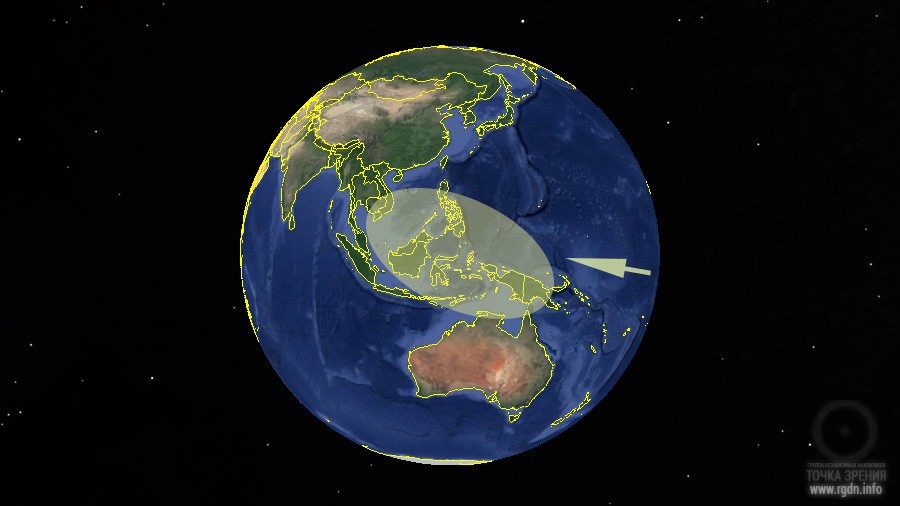
First of all, it is noteworthy that this area (I mean Indonesia) possesses quite a rich sacral and architectural heritage. This part of the world, especially Java and Bali islands, teem with numerous uniquely beautiful exotic ancient monuments, which attract tourists from all over the globe. Just Bali alone is so remarkable and called “the island of a thousand temples” not without reason.
However, my quest started with difficulty. I found nothing in the Philippines and Papua New Guinea. The two most significant temple complexes of Indonesia (Borobudur and Prambanan), based on official records, were erected earlier – in 790-860 AD and in the late 9th – early 10th centuries AD, respectively. I had to spend many hours on Google Earth, searching for and scrutinizing grounds, towers, foundations, masonry, and so on. Information was scanty and dates were too approximate. In a word, I proved to be completely in the dark about Indonesia, though more attentive examination showed that constructors of Indonesian buildings had obviously possessed knowledge of both sacred geometry and the precessional cycle relating to equinoxes, and many of their cult sites were linked to observations of “solar roads”. Nonetheless, it is impossible to prove anything of that so far. At that, the following strangeness amazed me: some objects had been created so as to observe sunset rather than dawn! In other words, they are oriented to the west, unlike the absolute majority of similar complexes all over the world. Why so? Or did it only seem to me?
At a certain stage of my search I recalled a nice Soviet song saying, “Who is searching will always find”, and eventually my quest unexpectedly succeeded right before the article publication. I delayed the publication for a day, but it was worth it, thank God.
Muara Takus is a Buddhist temple in Indonesia, built in the era of Srivijaya city-state (11-12th centuries AD). It is situated in Kampar Regency in Riau province, Sumatra. This is, perhaps, the largest and best preserved temple complex in Sumatra.
Undertaking a more thorough search of photographs on the web, I encountered the following image: a symbolic “chetverik” is carved in stone, in the middle of which there is an inscription with the clearly visible AllatRa sign above every hieroglyph:
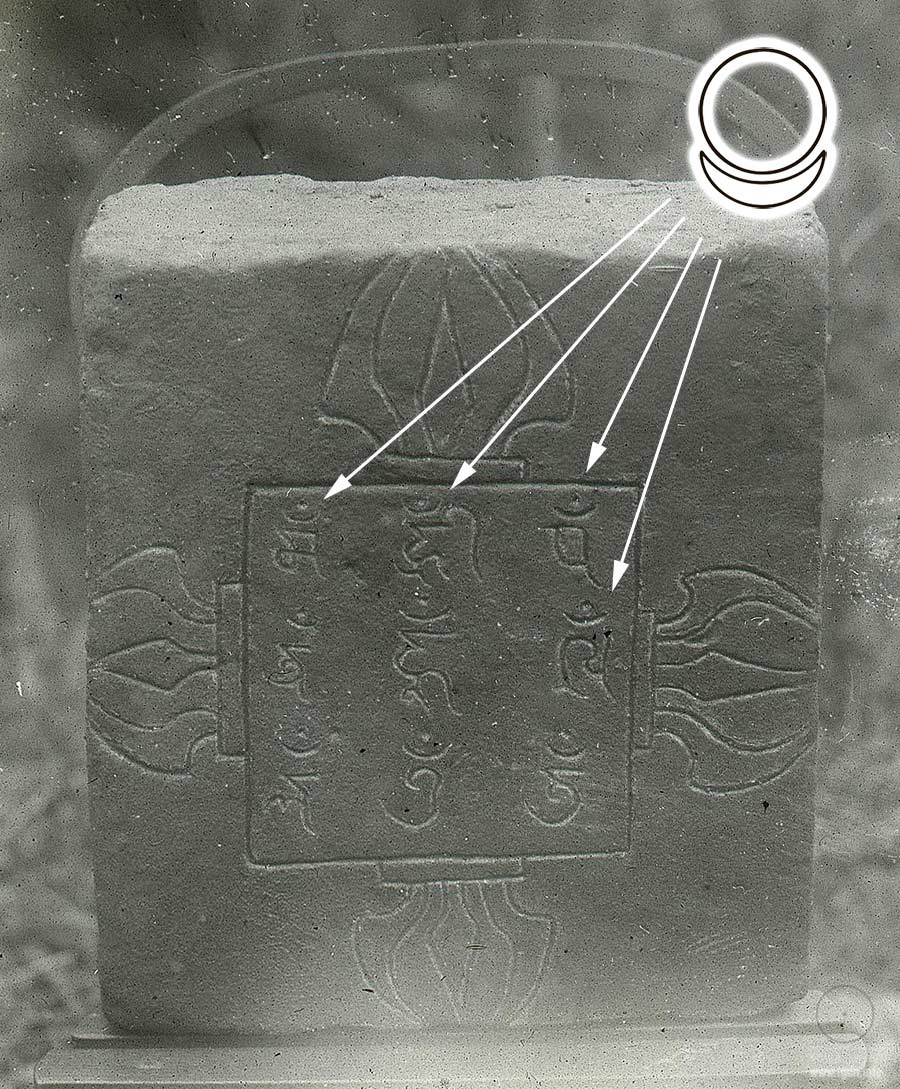
Muaro Jambi is a Buddhist temple in Jambi province, Sumatra. The temple complex was constructed by inhabitants of the ancient Melayu Kingdom. It is dated to circa 11-13th centuries AD.
Candi Ijo temple is located 4 km away from Ratu Boko or about 18 km eastward of Yogyakarta, Indonesia. Its construction took place during the 10-11th centuries AD. It is oriented in such a way that sunset may be observed.
The name of Goa Gajah (literally translated as “the Elephant Cave”) firstly misleads, creating an impression of a giant dwelling of elephants. In actual fact, Goa Gajah is an archaeological site of a great historical value. According to some records, Goa Gajah was built by Buddhist monks in the 11th century, as a spiritual site for meditations. It includes two small caves cut in a rock in the midst of jungle.
Uluwatu is a sublime marine temple situated 97 m above sea level, at the very edge of a cliff. Uluwatu is among the six most important temples on the island and proudly called the MajesticTemple on the Edge of the Earth.
Pura Luhur Uluwatu was founded in the 11th century AD by the Bali saint Mlu Cuturana and is dedicated to the goddess of seas Devi Laut. This temple, just like many other Bali temples, is associated with the name of the legendary Brahmin Nirarthi who lived here in the 16th century. In his memory, a three-level pagoda was erected in the temple territory, in the place where the prophet had achieved enlightenment.
Pura Besakih (“the MotherTemple”) is the main and most sublime temple in Bali, located at the foot of the dormant volcano Gunung Agung. The Mother Temple complex includes 22 temples, constructed as terraces that lead to Pura Penataran Agung sanctuary. Pura Besakih is dated to the 11th century AD. Due to its large scale, the temple construction required unification of efforts of all Bali kingdoms. The area of the temple complex is about 3 square kilometres. It is the site where religious ceremonies are still carried out. The site hosts Piodalalan festival once a year in October, Panca Wali Krama once in ten years, and Ekadasa Rudra (the grandiose exorcism ceremony) once in every century.
The mysterious Goa Lawah temple is also famous as the Bat Cave Temple. The temple sanctuary represents a magnificent sample of Bali architecture, executed of black volcanic stone and richly encrusted with gold. Goa Lawah is believed to have been erected in the remote 11th century.
In the first half of the 11th century AD, Bali was under the influence of Java Island. At that time the famous stone monuments in Gunung Kawi appeared. The Gunung Kawi complex itself was built in circa 1080 by the King Anak Wungsu. It is interesting that no remains of burial sites have ever been found there. Hence, just like in the case of the Egyptian pyramids, we can boldly assume these are not tombs at all.
The personality of the King Anak Wungsu who ruled in Tampaksiring (Bali province) in 1050-1078 AD deserves attention, too. He has remained in people’s memory as the king of mercy who brought safety, peace and prosperity. Among descriptions of his virtues the following arrested my attention:
People considered Anak Wungsu to be an incarnation of Lord Hari – the God of Good.
The find that impressed me the most!
In Hinduism, Garuda (Sanskrit गरुड, garuḍa – “the all-devouring sun”) is the mount (vahana) of god Vishnu and the fighter against snakes (nagas). In Vajrayana Buddhism, it is one of the symbols if the enlightened mind (see Wikipedia). Garuda is also called the sacred bird. Here we once again encounter the birdman image that we have earlier found in the Permian Animal Style (Russia), in the legend of Quetzalcoatl (Ancient Mexico), in the Sican civilization, on Easter Island, and certainly in Ancient Egypt.
Here is what we find in Wikipedia:
According to the Hindu, Garuda’s prey is snakes nestling in minds of those who don’t believe in or have doubts about God. In Indonesia it is associated with solar energy. Legend says Garuda brought Soma juice from the third heaven to Indra and people. The cult of Garuda was particularly widespread in the 10-12th centuries, in the age of Mataram (early) and Kediri. The image is reflected in sculpture and temple reliefs of that time (Chandi Belahan).
Many of you remember that people associated Soma with the sacred drink of immortality. As for who brought Soma to whom, legends are rather contradictory, at least the internet presents everything in a very tangled way, although there is interesting information, too, such as: “Garuda is the name of an enormous wise birdman who served as aircraft for god Vishnu”, or “Garuda is the son of Kashyapa, one of Saptarishi – the seven Vedic sages from who knowledge originated” (do you recall the Sages mentioned in Edfu Building Texts of Ancient Egypt?)
We can also recall similar characters from Old Russian art and literature: incidentally, the heavenly birds Sirin and Alkonost were first mentioned there exactly in the 10-12th centuries AD.
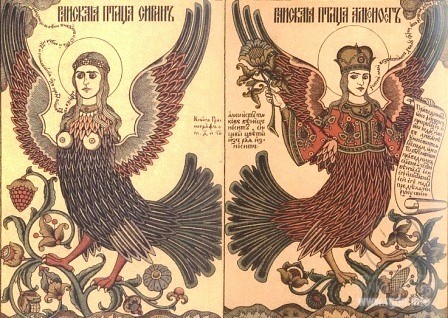
By the way, Indra is mentioned in the AllatRa book:
Rigden: … Let us take Old Slavic legends and epic tales recorded in the ancient Russian collection of spiritual songs called The Pigeon Book (the book that got banned by religious ministers in the 13th century), in which the unicorn is referred to as Indrik-Beast (Indra). It contains the following lines:
“Our Indrik-Beast is the main beast,
And he goes, the beast, in the dungeons,
He crosses all the mountains of white stone
And clears all the creeks and streams.
When this beast leaps in joy,
The entire Universe stirs up.
All other beasts bow to this one beast,
And he never hurts anyone.”
Anastasia: Yes, I came across these epic poems which describe the worldview of ancient people, including matters of cosmology, sociology and spiritual knowledge. But I got interested in them I had started to realise their spiritual essence and learned how to separate the wheat from the chaff. For instance, Indra is said to be living on the HolyMountain; he eats and drinks from the BlueSea, walks horn-like through the dungeons akin the sun in the skies. Considering that the HolyMountain is a symbol of transition to another dimension, water means the spiritual world, and the spiral-like horn, with which Indra “walks through the dungeon”, stands for astral travels by means of “tunnelling”, where the “tunnel” is often twisted into a spiral, then the book turns out to be quite interesting!
Rigden: Had you seen the original version of these epic songs, which the ancestors of the Slavic people once possessed, you would be surprised at the simplicity of the Truth and the spiritual Knowledge enclosed in such symbols. But, unfortunately, little is left of the version of these tales that reached contemporary people. And it is not only because of distortions that accumulated throughout centuries of the transfer of the Knowledge. Unfortunately, these epic stories were considerably altered when Christianity began to be propagated, and the “pagan”, originally Slavic beliefs began to be destroyed; in some cases, the information was replaced while in others it was altered; some birch bark manuscripts with Old Slavonic records were also burned completely. This is exactly when significant substitutions occurred with an emphasis on the ideology of the Christian religion.
For example, previously one of the epithets of Indra was “phar”, which in Old Russian means a “thoroughbred horse”, a “racer”. Ministers of the Christian religion took advantage of this, and the unicorn in their legend lived not on the Holy Mountain mentioned in Russian epics, but on the sacred Mount Tabor in Palestine, which in the Christian tradition is considered to be a place of the Transfiguration of Christ. But what I would like to say about the epithet “phar” itself. The ancient Slavs used this word in the meaning of a “stallion” with respect to Indra (the unicorn), and it is also a human interpretation of the Knowledge. According to the original legend (which once was known not only in the territories inhabited by the ancestors of the Slavic people, but also in Ancient India, Ancient Iran (the Zagros Mountains), the Front Aspect, which was symbolically represented by the unicorn, was linked with the Farno, or the Grail if we speak in modern terms. The Farno (the Farn / Pharn in the Orient) was defined as the shining principle, the divine fire that multiplied power, control and might. It’s been mentioned that Farno helps the human Soul to pass the bridge that leads to eternal life. Now, match all this with the knowledge you already possess.
Anastasia: For me, this information, just like every meeting with you, is another discovery! Now, first of all, it is clear why ancient Russian huts and shrines had two wooden horse heads with a large solar symbol (a circle). By the way, such tradition was widespread not only in Russia, but also among the ancient peoples of the Baltic and Europe. It turns out, besides the fact that it was a stylized AllatRa sign, it was also one of the ways to interpret the ancient sacred legend about the unicorn and Farno. Secondly, if the legend has a common Indo-European root, then its echoes (and, consequently, the remains of the Knowledge) must be sought not only in the ancient epic, but also among literary monuments of Ancient Iran and Ancient India.
Let us take Ancient India, for instance. The most popular Vedic character there was god Indra. Translated from ancient Indian, the root of the word “Indra” means an indication of the spiritual Power. Interestingly, it is mentioned that the ability to have many forms is peculiar to this god and that he can turn into horsehair. Indra himself appears in myths as the god of Heaven, who is connected with rain (water), releases rivers and streams, and pierces channels (just like the Slavic Indrik the unicorn). He is the “son of power”, “drinking soma”, friendly and always ready to come to the aid. Moreover, most importantly, according to the legend it is exactly Indra who fights alone and conquers dragon Vritra (the demon of chaos), whereas his victory is equivalent to the victory of the dynamic principle (the powers of Allat) over the stagnant chaos (the Animal Mind) and leads to organization of the Vedic world of “broad spaces.” The battle is the central plot of the legend. If we consider that the Hindu “Vrtra” (Vritra) is literally translated as “congestion” or “barrier”, and that Indra represents spiritual power, then, in essence, it all means overcoming the Animal Nature, the spiritual victory of man over himself, his liberation.
Rigden: Besides, Indra is believed to be the Guardian of one of the four cardinal directions. There is also a reference related to the Knowledge about the structure of the world, in particular that Indra rules over Svarga (Heaven); according to beliefs of the Hindus, it is a paradise located on the top of MountMeru. Now let’s recall that in the Slavic and Russian mythology there was also god Svarog – the god of Heaven, heavenly fire, the father of Dajdbog and Svarozhich. In The Tale of Bygone Years, the all-Russian chronicle of the beginning of the 12th century, which was included in the Hypatian Codex, the following mentions of it have been preserved: “...сего ради прозваша и богъ Сварогъ... и по семь царствова сынъ его именемъ Солнце, его же наричють Дажьбогъ... Солнце царь, сынъ Свароговъ, еже есть Дажьбогъ...” (“...for this cause, he was called god Svarog ... and his son under the name of the Sun ruled over seven kingdoms. He was named Dajdbog ... The king of the Sun, Svarog’s son, he is Dajdbog...”).
(the AllatRa book, pages 421-424 – allatra.us)
Garuda is the national symbol of Indonesia and Thailand. It is present on the coat of arms of the Mongolian capital city of Ulan Bator and may be found in Angkor Wat relief in Cambodia, as well as in Tibet, Japan, Vietnam, Laos, Hawaii, and certainly India. Furthermore, god Vishnu is often portrayed on this majestic bird.
Yet, the most unexpected and pleasant discovery was in store for me later, when I almost finished collecting photographs into my folder. Suddenly I saw a circle and a crescent on Garuda’s forehead. It turns out this sacred bird bringing immortality to people was often depicted with the AllatRa sign! Why is the sign here? We can only conjecture. Over again we come to the conclusion that the knowledge is single.
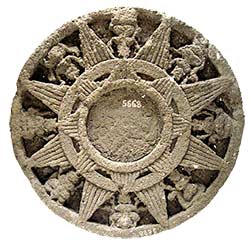 The history of Bali is closely connected with that of adjacent Java. In the 11th century AD the influence of Java, which was then Hindu, could be traced in culture, cuisine and visual arts. Such a close connection between the two islands became possible after the establishment of the power of Java King Airlangga, whose mother later one moved to Bali. The island’s autonomous status remained until 1284 when Java King Kertanegara conquered independent Bali.
The history of Bali is closely connected with that of adjacent Java. In the 11th century AD the influence of Java, which was then Hindu, could be traced in culture, cuisine and visual arts. Such a close connection between the two islands became possible after the establishment of the power of Java King Airlangga, whose mother later one moved to Bali. The island’s autonomous status remained until 1284 when Java King Kertanegara conquered independent Bali.
Kertanegara’s reign was short because he was killed 8 years later, in 1292. However, his son named Vijaya started the “golden age” on Java and Bali islands. He was destined to found the Majapahit Empire that was the most powerful state in the region and influenced vast territories from Malaysia to the Moluccas. That period of Bali history abounds in records of prosperity and spiritual evolution, and construction of many temples started exactly at that time.
The Majapahit Empire is the last Indianized kingdom in Indonesia, dating back to 1293 – circa 1520 AD. The island empire was situated on eastern Java with the capital city of Majapahit. The empire was founded by Prince Vijaya of the Singasari dynasty. While the empire existed, medieval Indonesia reached the highest level of centralization. Entire Java was united under the power of Majapahit rulers. Later on the most developed regions of Madura, Sumatra, Sumbawa, Sulawesi, the Moluccas and the Malay Peninsula were added to the empire territory.
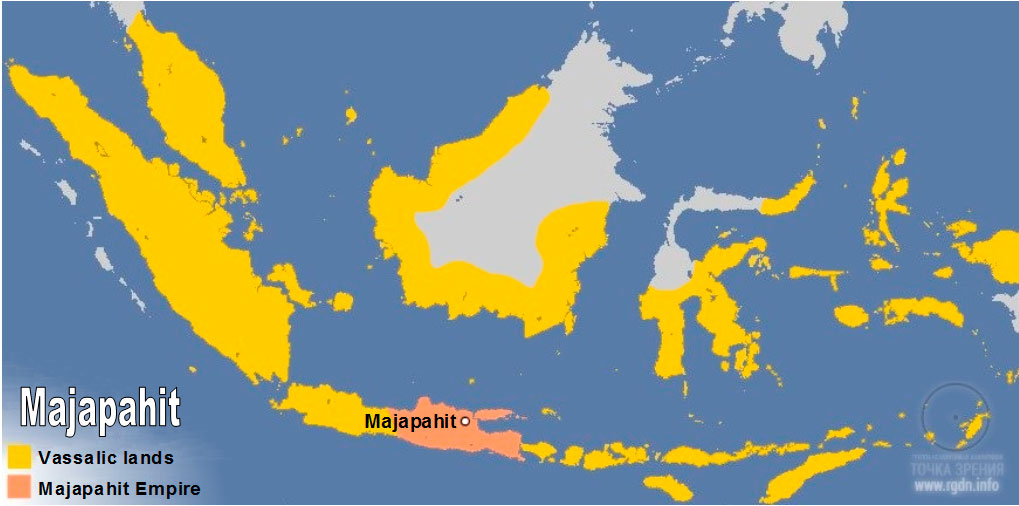
This time it seemed to me I could not manage to collect a relevant number of convincing evidence that would permit to assert that a noticeable spiritual surge had taken place on the islands of South East Asia in the 11th century AD. I failed to find any traces of renaissance in the aforesaid period of time in neither the Philippines nor Papua New Guinea. There are remains of ancient architecture dating back to that period in Indonesia with its quite rich historical heritage, where the most interesting, in my opinion, is the period of reign of the King Anak Wungsu (incarnation of the God of Good) who brought cultural flourishing in 1050-1078 AD. Moreover, it is appropriate to refer to the golden age of the Majapahit Empire between 1293 and circa 1520, as the brightest episode of stability and unity in Southeast Asia of that time.
What saved me was the sacred bird (birdman) Garuda with the AllatRa sign. The cult of Garuda emerged exactly in the 10-12th centuries AD, though I cannot say owing to whom or what it emerged. Perhaps, the traces of the cultural surge on both American continents and the PacificIslands directly relate to this.
Where are we going next? To Cambodia...
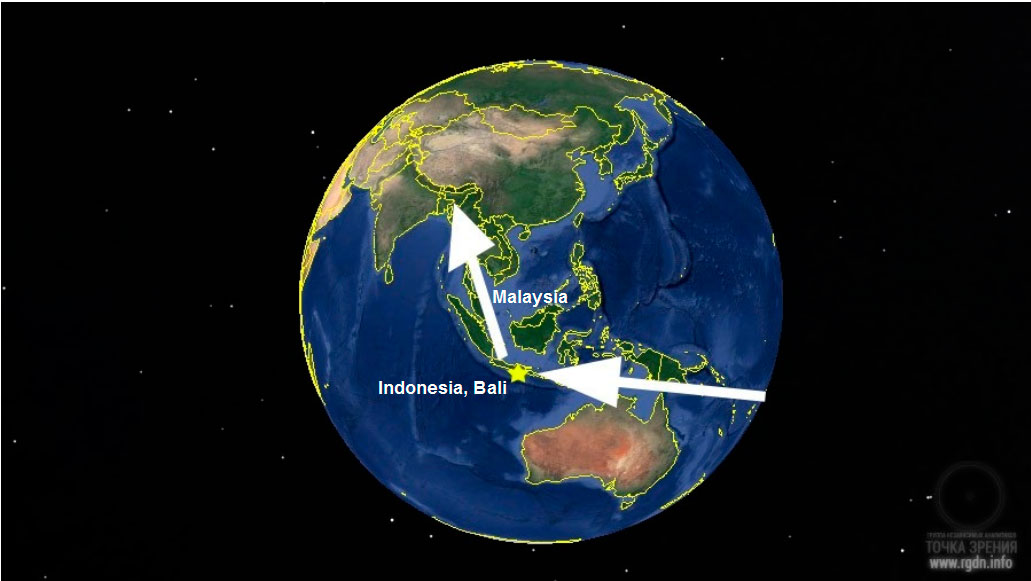
To be continued...
Prepared by Dato Gomarteli (Ukraine-Georgia)
 In quest of... The 11th century. Southeast Asia (Indonesia, Malaysia). Part Five
votes:
127
In quest of... The 11th century. Southeast Asia (Indonesia, Malaysia). Part Five
votes:
127
|

Project Aim










Leave comment